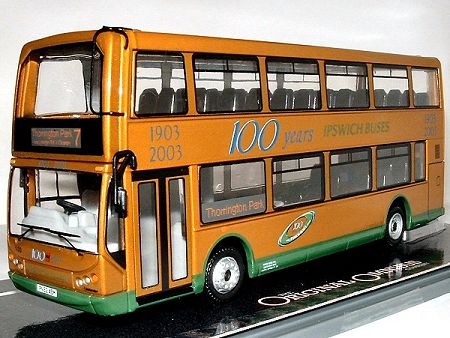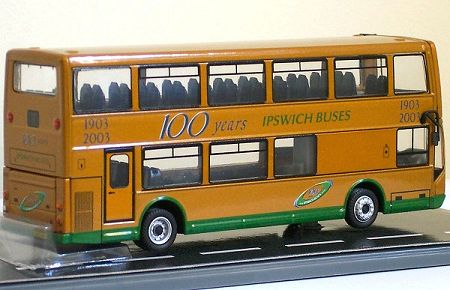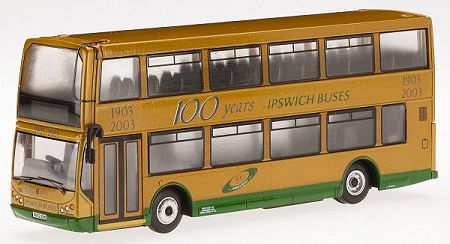| E. Lancs (Myllennium) Lowlander | ||
| OM42501 | ||
|
Ipswich Buses |
||
 |
|
This picture shows the final production of this model Photograph © S & D Models Please see bottom of this page for a review of the model written by Mark Smith
|
| Manufacturer of model | Corgi OOC |
| Scale | 1:76 |
| Fleet number | 100 (The actual fleet number for this vehicle is 54. 100 was applied for Centenary purposes only) |
| Registration number | PN52XBM |
| Route number | 7 |
| Destination | Thorrington Park |
| Advertising | Ipswich Buses Centenary |
| Release details | |
| Quantities (if known) | n/a |
| Date released | 7/03 |
| Availability | General release |
| Comments | This model is not a limited edition |
|
This picture shows the production version of this model Photograph © Frank Houlden
|
|
This picture shows the production version of this model Photograph © Mark Smith
|
|
This picture shows a pre production sample of this model Photograph © Corgi Classics Ltd
|
|
East Lancs Myllennium Lowlander Review By Mark SmithI am grateful to Gareth for giving me the opportunity to review the first OOC issue of the modern family of East Lancashire Coachbuilders models – the Lowlander (on DAF DE02PSDB250 chassis), The Lolyne (on Dennis Trident T2) and Vyking (on Volvo B7TL). The first issue, OM42501, represents Ipswich Buses DAF No.100, painted in the company’s centenary livery – a vehicle I have driven on service for Ipswich Buses a couple of times during the last couple of months. Many are grateful to Corgi for producing an Ipswich model at last – to date we’ve only had the 1:50 scale Utility trolleybus. This is therefore an eagerly awaited release, and we know that Corgi can produce a top-notch model (The AEC Q ‘decker springs to mind). So how does this one shape up? It would appear one basic casting has been tooled to represent all three chassis/body variants. Although the prototype chassis lengths and heights of the different types vary between marques, this I am sure, is a commercial consideration acceptable to most collectors. This review concerns itself with the comparison of dimensions of the DAF/Lowlander version. The new casting scales at approximately 10.7m long, 4.1m high and 2.53m wide. This is correct for the long wheelbase DAF chassis and low height (4.1m) variant of the Lowlander (the most common variant), although the vehicle modelled in reality is a 4.335m high version. Consequently the deeper upper deck windows, a noticeable characteristic of the real thing, have been modelled at the same depth as the lower, giving slightly squat look. The front upper and lower deck body mouldings are separate fittings, thus enabling Corgi to model the various East Lancs frontal styles. The engine door opens, revealing a black plastic engine, there are prototypical looking plastic mirrors, etched wipers and an etched tree deflector bar. The inclusion of this detail is unfortunate, as the real Ipswich vehicle does not have (and never has had) a tree bar! The main body is a single piece casting, with basic panel details moulded on and is sprayed in the correct shade of gold and Ipswich Green. The printing is crisp and clear and in the centenary wording is in the correct typeface (Dream Orphans), which I understand was designed for Ipswich Buses and is not readily obtainable. Printed detail then suffices for access flaps, fuel filler, engine grilles and the like and is acceptably defined. The main casting joint with the separate front-end fittings is rather thick when compared to the real thing, but this thickness is needed for the structural rigidity of the model. The upper deck front moulding is spray painted clear plastic, and is slightly opaque under ‘normal’ lighting conditions. The gasket-glazed windows of the prototype are represented by printing on the clear glazing material, doubtless to enable Corgi to replicate bonded glazed versions on other models. Unfortunately the gold ‘painted’ pillars as printed scale approximately 150mm wide, whereas in reality they are around half this width. The Mobitec electronic destination screens are generally well done, except the side screen is twice as wide and twice the depth of the real thing. The interior, again a ‘generic’ item not particularly accurate to this particular vehicle, is at least coloured pale grey and black to accord with the basic colours internally on real thing. What really disappoints is the lack of attention to obvious details, which could easily been deduced from photographs in many cases. They include: § The fictitious tree bar on this version (may be appropriate for other operators) § The poorly scaled side destination display § Side trafficators printed in the wrong positions and nearly invisible § Prominent emergency door button and wheelchair symbol missing by the entrance § Various other transfers omitted, including ‘Emergency Exit’ wording and DAF badges omitted front and rear § Prominent interior grab rails not even printed (eg door handrails, front upper deck grab rail – now included on most Hong Kong models) § Centre exhaust hole in rear bumper appropriate to DAF chassis § Prominent fictitious beading on rear engine door (to facilitate opening door ‘novelty’) Do these points matter or am I rivet counting? I don’t think I’m rivet counting because all I look for in a 1:76 casting is the character of the prototype. I accept there are tooling limitations and will be dimensional compromises. Having said that, the model I’ve reviewed just doesn’t look like the vehicle I’m familiar with. The basic shape is there, but the pillars are jarringly wide and some of the subtle detail points appropriate to the Lowlander design are wrongly depicted. The real shame is that most of the obvious detail mistakes noted could have been avoided by a more careful audit of the real thing at the pre-production stage. Verdict – A welcome release, but not one of Corgi’s best OOC models.
|
|
This page last updated Monday, 08 June 2020 |
| © British Model Buses 2020 |

